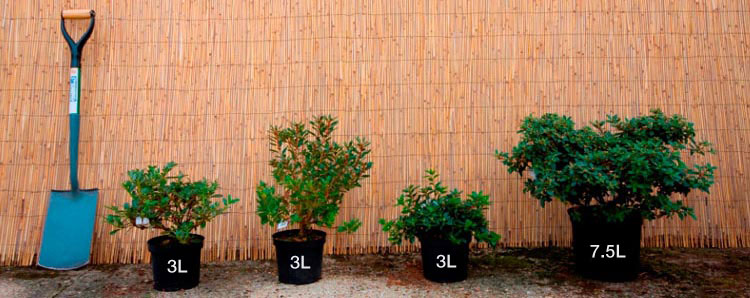Parrotia perscia Persian Spire
Item: PARRPERS
 In stock
In stock
200-400cm
Not Scented
Yes
To -20 °C
Collect in Store
This item is available for collection.
Home Delivery
UK mainland delivery from £8.95
Photo of 12 litre plant shown in third photo.
These trees sit at approximaltey 180-200cm not including the pot. They will come via Parcel Force on a 48 hour delivery due to height or they can be collected directly from the nursery.
(H6) Small upright tree with attractive foliage. New leaves are dark green with a striking purple border, turning yellow orange and red in autumn. Very hardy, ideal for small gardens. Height 2-4m in 10 years. All good fertile soils.
Parrotia Persian Spire is never short of a colourful outfit! Its exquisite sense of style perfectly matches its elegant shape. Parrotia Persian Spire is characterized by its narrow, upright growth. Perfect for use in small gardens! Apart from its shape, this Parrotia also distinguishes itself with its fine leaves. In spring, purple shoots appear. In summer, Persian Spire has dark green leaves with a striking purple border. In autumn, its foliage will turn yellow/orange/red. Persian Spire is hardy to -30° Celsius and deciduous. It’s best placed in moist soil, in partial shade or in a sunny spot. After 7 years without pruning, it will reach a height of 250 cm and a width of 75 cm. Persian Spire is the first Parrotia that can be planted in a small garden or as solitary for on your terrace or balcony.
Good to know
We offer a range of our favourite plants which associate well with rhododendrons. They all like similar growing conditions – moist acidic soil and dappled shade. Some of these are featured in our garden at Crosswater Farm, and often create plenty of interest and enquiries. Many are fairly rare and are unavailable elsewhere, but deserve to be better known.
All require good moist acidic soil with a high organic content, planted with good ericaceous compost. For a guide to plant spacing, use the height we give in 10 years as a guide to the distance between each plant. Plant no deeper than the top of the rootball, and dig in plenty of good ericaceous compost around the sides. A teaspoon of slow release feed is sufficient for a 3 litre plant, rising to a small handful for a mature plant.
For further advice, For further advice, see here
The Basics
Ideal soil
Acidic soil, good organic content, pH 4.5-6.0. Inkarho range of rhododendrons will tolerate soils up to pH7.5
Sun or Shade
Light dappled shade is best for most varieties.
Shelter
Refer to hardiness rating. Give young plants protection.
Site Selection
Avoid close to trees, roots, invasive weeds, walls, hot patios, dry banks and waterlogged soils. Do not use weed matting or stone mulch.
Plant spacing
Use the height shown in 10 years as a guide to the distance between each plant. Allow room for plant to fill out. If planting closer for instant impact, be prepared to move plants after a few years.
Compost
- 3 litre pot, dig in 10-20 litres of ericaceous compost.
- 7.5 litre pot, dig in 20-30 litres of ericaceous compost.
- 70-80cm specimen, dig in 60 litres of ericaceous compost.
- 100-120cm specimen, dig in 120 litres of ericaceous compost.
Planting depth
Plant high in the ground, with the top of the rootball visible.
Feeding
Slow-release ericaceous feed recommended in March and straight after flowering.
Mulch
Recommended every few years.
Water
The key ingredient! Keep moist all season, especially the critical time at end of June for flower bud initiation. Tap water is better than no water. Heavy dose at least once per week in dry weather.
Drainage
Ensure good drainage in winter, especially with yellow flowering varieties. Avoid waterlogged sites.
Pruning
Rhododendrons and Camellias: Not normally required. Tidy wayward shoots after flowering.
Evergreen azaleas and Bloombux can be clipped into a low hedge.
Magnolias and Acers: Formative pruning when young to shape into a tree or bush.
Deadheading
Remove old flower-heads, particularly on young or weak plants.
For further advice see here
Size Guide

Delivery & Returns
Our website calculates the delivery charge according to weight and delivery location throughout the UK. To see these charges, please enter your postcode at the checkout, and you will see the charge vary as you add more items to your wheelbarrow.
 Millais Nurseries
Millais Nurseries





